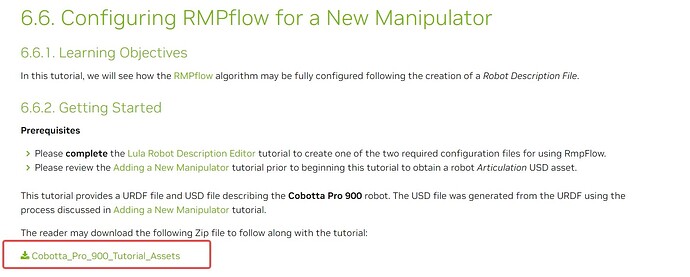Hi everyone, I am trying to test RmpFlow using a cobotta_pro_900 robotic arm. I used a tutorial case where “end Effector” is “right-inner_finger”, but I encountered a strange problem where its execution was accurate when it approached “baseunlink” (or close to cobotta_pro_900 itself). But when he is far away, he will have a very large margin of error. It seems that calculations can only be carried out within a certain range.

I also tried Frank and customized a robotic arm (which has no axis restrictions and is completely free). Even if the robotic arm is very long, a similar situation occurred. It always accurately executes the “Follow Target” within a certain range. If it exceeds the range, it will be inaccurate and the range will be very small.
I want to know if there are any parameters or method adjustments. It is very important to me and I hope to receive everyone’s help.
cobotta_rmpflow_config_basic.yaml
joint_limit_buffers: [.01, .01, .01, .01, .01, .01]
# RMPflow has many modifiable parameters, but these serve as a great start.
# Most parameters will not need to be modified
rmp_params:
cspace_target_rmp:
metric_scalar: 50.
position_gain: 100.
damping_gain: 50.
robust_position_term_thresh: .5
inertia: 1.
cspace_trajectory_rmp:
p_gain: 100.
d_gain: 10.
ff_gain: .25
weight: 50.
cspace_affine_rmp:
final_handover_time_std_dev: .25
weight: 2000.
joint_limit_rmp:
metric_scalar: 1000.
metric_length_scale: .01
metric_exploder_eps: 1e-3
metric_velocity_gate_length_scale: .01
accel_damper_gain: 200.
accel_potential_gain: 1.
accel_potential_exploder_length_scale: .1
accel_potential_exploder_eps: 1e-2
joint_velocity_cap_rmp:
max_velocity: 4.
velocity_damping_region: 1.5
damping_gain: 1000.0
metric_weight: 100.
target_rmp:
accel_p_gain: 30.
accel_d_gain: 85.
accel_norm_eps: .075
metric_alpha_length_scale: .05
min_metric_alpha: .01
max_metric_scalar: 10000
min_metric_scalar: 2500
proximity_metric_boost_scalar: 20.
proximity_metric_boost_length_scale: .02
xi_estimator_gate_std_dev: 20000.
accept_user_weights: false
axis_target_rmp:
accel_p_gain: 210.
accel_d_gain: 60.
metric_scalar: 10
proximity_metric_boost_scalar: 3000.
proximity_metric_boost_length_scale: .08
xi_estimator_gate_std_dev: 20000.
accept_user_weights: false
collision_rmp:
damping_gain: 50.
damping_std_dev: .04
damping_robustness_eps: 1e-2
damping_velocity_gate_length_scale: .01
repulsion_gain: 800.
repulsion_std_dev: .01
metric_modulation_radius: .5
metric_scalar: 10000.
metric_exploder_std_dev: .02
metric_exploder_eps: .001
damping_rmp:
accel_d_gain: 30.
metric_scalar: 50.
inertia: 100.
canonical_resolve:
max_acceleration_norm: 50.
projection_tolerance: .01
verbose: false
# body_cylinders are used to promote self-collision avoidance between the robot and its base
# The example below defines the robot base to be a capsule defined by the absolute coordinates pt1 and pt2.
# The semantic name provided for each body_cylinder does not need to be present in the robot URDF.
body_cylinders:
- name: base
pt1: [0,0,.33]
pt2: [0,0,0.]
radius: .05
# body_collision_controllers defines spheres located at specified frames in the robot URDF
# These spheres will not be allowed to collide with the capsules enumerated under body_cylinders
# By design, most frames in industrial robots are kinematically unable to collide with the robot base.
# It is often only necessary to define body_collision_controllers near the end effector
body_collision_controllers:
- name: right_inner_finger
radius: .05
